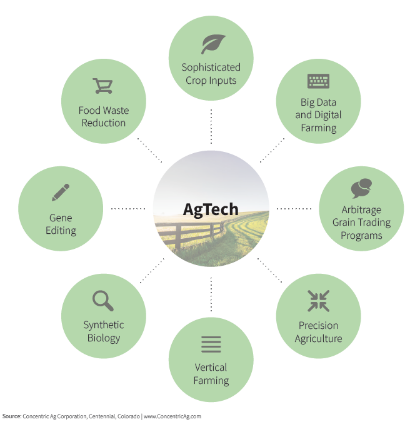Agrochemicals
AgTech innovation is broadening to many fronts 10th December 2018
By Donald R. Marvin, President and CEO of Concentric
Donald R. Marvin, President and CEO of Concentric, considers the most promising areas of endeavour in agtech. When so
Donald R. Marvin, President and CEO of Concentric, considers the most promising areas of endeavour in agtech.
When some of us first started talking about a Second Green Revolution back in 2015, many of us were most excited about nurturing agricultural soils through better farming practices such as conservation-tillage and no-till farming — and we still are.
But three years later, we’re now seeing an emerging landscape of a broader agtech sector that’s pursuing high-payoff ag solutions and attracting major investment dollars.
Initially, agtech innovation focused on developing biological crop treatments for growers and on developing so-called ‘precision agriculture’ technologies. In three short years, early agtech advancements are already changing the face of farming. Though agtech is still defining itself, early agtech-driven innovations — disease-resistant seeds, biological crop inputs, more-precise nutrients, data-driven farm management and robotics — are already part of the grower’s toolkit. These innovations are directed at improving on-farm productivity and, secondarily, curtailing food waste.
Yet, as of today, agtech is only scratching at its full potential. Listed below are the sectors that I believe hold the most promise for enhancing agriculture’s ability to feed the world, while also making more money for farmers and improving our agricultural environment.
Private equity investors are already becoming aware of the broader potential of the sector. According to AgFunder, $4.2 billion in private investment flowed into agtech companies in 2017 — part of a broader $10.1 billion that was invested in agrifood tech companies across the supply chain. That figure is expected to grow in 2018.
In no particular order, the most promising areas of endeavour are described below.
Sophisticated crop inputs
Crop inputs have become diverse and more precise. Once poorly understood, biologicals will soon become a standard part of every grower’s regimen. Some companies are focused on biocontrols that help plants fight disease. For example, our current efforts at Concentric focus on the combining of nutrients with our proprietary biologicals to enhance plant health and yield.

Big data and digital farming
The influence of big data is being felt throughout the agriculture and food supply chain. Large amounts of data produced by smart sensors and other devices permit farmers to pursue increasingly precise protocols in areas ranging from cover crops to irrigation systems.
Arbitrage grain trading platforms
These are digital platforms that connect buyers with growers to form real-time marketplaces, giving farmers more control over their markets. They are attracting interest from investors and growers alike.
Precision agriculture
Increasingly sophisticated software and hardware tools make for more effective use of data in making planting decisions, applying fertilizers, assessing and improving soil health, determining nutrient quantities and types, and monitoring growing crops.
Vertical farming
This segment is all about growing food in controlled environments, stacked into vertical layers that can range from shipping containers to tall buildings. These hydroponic environments provide plants with precise nutrient mixes while also requiring less water and minimizing agricultural runoff.
Synthetic biology
This is a large category that encompasses efforts to design or redesign food production (as well as other biological systems) by drawing on leading-edge science from fields as diverse as molecular biology, computer science and chemical engineering.
This is a large category that encompasses efforts to design or redesign food production (as well as other biological systems) by drawing on leading-edge science from fields as diverse as molecular biology, computer science and chemical engineering.
Gene editing
In commercial and academic labs, Ph.D.-heavy teams of biologists, geneticists and computer scientists are developing better tools and methods for editing living cells. One result can be differentiated food products that hold more appeal for both growers and consumers alike.
In commercial and academic labs, Ph.D.-heavy teams of biologists, geneticists and computer scientists are developing better tools and methods for editing living cells. One result can be differentiated food products that hold more appeal for both growers and consumers alike.
Food waste reduction
The UN’s Food and Agriculture Organization says more than one-third of all food produced globally is wasted.1 Science is finally getting to work on diverting some of the mountains of food heading for landfills, ideally channeling some of it to hungry people. Solutions being pursued include techniques for keeping produce fresh longer without refrigeration, online marketplaces for selling food that’s not cosmetically perfect and better software tools to help food retailers manage unsold inventory.
The UN’s Food and Agriculture Organization says more than one-third of all food produced globally is wasted.1 Science is finally getting to work on diverting some of the mountains of food heading for landfills, ideally channeling some of it to hungry people. Solutions being pursued include techniques for keeping produce fresh longer without refrigeration, online marketplaces for selling food that’s not cosmetically perfect and better software tools to help food retailers manage unsold inventory.
In summary, the field we call agtech, though perhaps not as high-profile as some other branches of science, has been quietly attracting money, smart management and armies of PhDs. With activity afoot on these various promising fronts, prospects are good for enlarging and qualitatively improving the global food supply.



